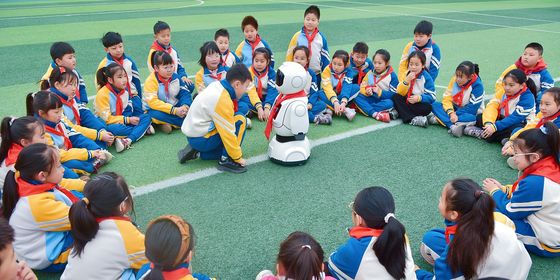China responds to spate of savage bullying incidents caught on camera
One afternoon in January of 2014, Xiao was on his way to an internet café in Beijing with two friends. The 14-year-old was confronted by two older boys; in an instant his friends had fled. The two older boys dragged Xiao out to a nearby open space where Guo was waiting for him. Media reports at the time indicated that Guo had been in trouble with the authorities for bullying in the past, for which Guo blamed Xiao. The result, caught on camera by one of the boys and which would later go viral online, was confronting in its brutality. Xiao was left beaten and his attackers urinated on his face.
This incident was just the first of many to show up online; students have been fatally stabbed or beaten by classmates, teachers have beaten students, students have beaten teachers, and one boy was taken away in the middle of an exam for emergency surgery after a beating had apparently left him with a ruptured spleen. And these are merely physical examples bullying—not to mention other forms of verbal, emotional, and psychological abuse.
Chinese schools aren’t typically known for bullying; when asked about it, many Chinese assume that students simply don’t have the time for it on account of all the studying that is required.
But the worrying number of filmed incidents of savage physical bullying that have gone viral online is a testament to the fact that China has a real bullying problem, both in schools and outside the school halls, and authorities are gradually acknowledging the scale of the problem.
RAISING AWARENESS
In May of 2016, the State Council issued a circular that instructed schools to set up anti-bullying measures, including hotlines and inspectors that will liaise with schools, and it specified bullying as being either physical or verbal. It was a rare sign of recognition at the highest levels of government and was echoed in June by Prime Minister Li Keqiang, who penned a letter on the best ways to end the cycle of campus violence. He suggested improving laws and regulations, improving students’ awareness of laws and rights, and, in typical official speak, told education authorities to “resolutely” put an end to behavior that disregards human dignity and lives.
If anything, the missives from the authorities, along with the reactions in the media afterward, indicated the complexity of the problem and the lack of tools available for dealing with it. The Beijing Review, for example, asked four experts to weigh in on the issue, but most ended up kicking the can toward parental responsibility, offering only vague hopes that “moral values” could improve with time and that the government must take harsher action against offenders.
As criminal psychologist Ma Ai points out that this problem is one that has to be viewed in a broad societal context. “School bullying has existed for a long time, both in ancient China and the present day,” he says, but hastens to add that there are definitely modern aspects to what we are seeing. “These attacks no longer fit into the behavior expected of juveniles, and society and parents are paying a lot more attention to the problem these days.”
He adds that it is difficult to gauge the actual rates of bullying, as media coverage now puts the incidents in a different light. Similarly, he cautions against making sweeping generalizations about the more recent trend of publicly sharing videos of this brutality. In some cases the videos are shared by the bullies themselves, but there are also plenty of cases where appalled bystanders have uploaded the videos. “We can’t know the motivations of every individual who posts these videos online, but generally, they are driven by their own emotions. They are rarely thinking about the teenage identity of the victims or the bullies.”
Online comments reveal how each commentator can look into the problem and see their own assumptions reflected back at them— some say the problem is that rapid development has left children without a moral compass, others agitate for harsher punishments. Some point out the many children left behind in rural areas as parents went to work in the cities. Others blame schools for not guiding students well enough, while plenty blame the heavy study workload for pushing kids to lash out. Some decry the gaps in the legal system or the ways in which minors can evade punishment. Minors of 16 years age or less are exempt from criminal liabilities, but not legal liabilities.
The Law of the PRC on juvenile crimes has specific regulations in terms of these crimes, but the problems tend to be in enforcement rather than a lack of laws.
But when online comments reference the response from authorities, there is one particular bullying incident involving Chinese teenagers that frequently crops up in discussions on the Chinese internet. This was because it didn’t even occur in China.
THE SAN GABRIEL INCIDENT
In January of 2016, three Chinese teenagers—Zhai Yunyao, Yang Yuhan, and Zhang Xinlei—were sent to prison for the March 2015 kidnapping and assault of their classmate Liu Yiran in California’s San Gabriel Valley, after a plea deal saw prosecutors drop the torture charge, which held a much stiffer sentence.
Zhai received 13 years in prison, Yang 10, and Zhang six. Zhang’s lawyer had argued that he was merely a bystander.
The trio forced Liu, who was 18 at the time, to wipe ice cream and cigarette butts off the floor of an ice cream parlor using her hands. Then, in a nearby park, they stripped her naked, slapped her, kicked her, and burned her with cigarette butts. At a hearing, the judge even referenced the William Golding’s classic tale of children embracing brutality, the Lord of the Flies.
While much of the online commentary focused on the issue of “parachute” children studying in the US without their parents, another key part of the response to the incident in China, as indicated by numerous online comments, ran contrary to the stereotypical Western view of authoritarian China: Chinese disciplinarians praised American laws for being tough on crime, lamenting China’s seeming inability to use laws to punish its own bullies.
That is to say, the Americans punished them and they were seen to be punished, but this kind of response is perceived as lacking in China.
These kinds of comments hinted at a broad sentiment that institutions are failing to provide an appropriate atmosphere for the Chinese students and by extension the strong belief in the importance of education held by Chinese parents.
The first instinct when faced by a bullying epidemic is to ask who is responsible, but there, things get incredibly murky.
“Schools of Hard Knocks” is a feature story from our newest issue, “Agriculture”. To read the whole piece, become a subscriber and receive the full magazine. Alternatively, you can purchase the digital version from the iTunes Store.












